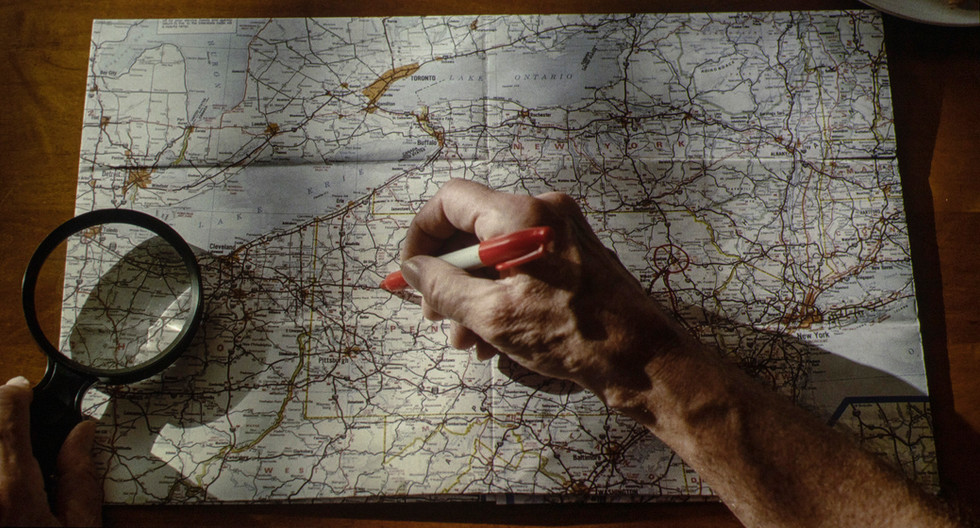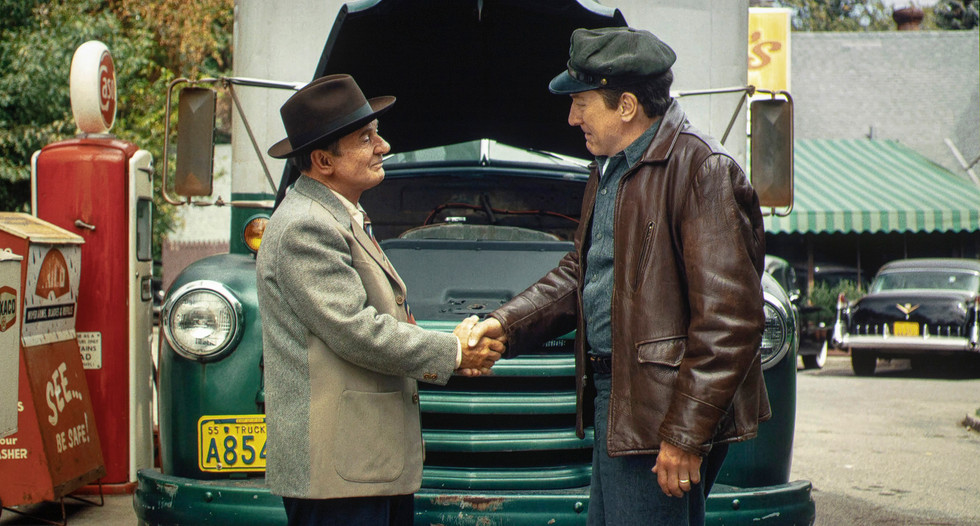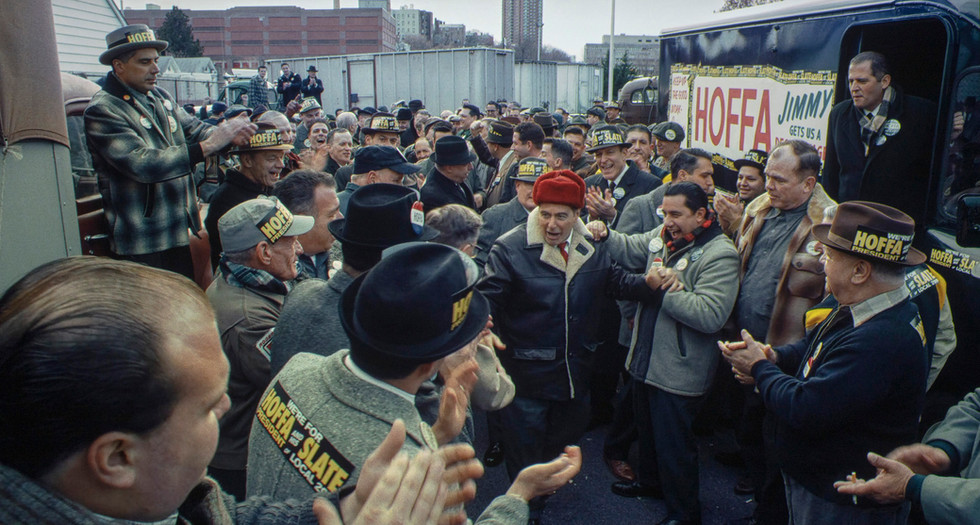Scorsese trades sentimentality for poignancy in rich, rewarding “The Irishman”
- Craig Shapiro
- Nov 28, 2020
- 8 min read
Updated: Jun 5, 2022
BLU-RAY REVIEW / FRAME SHOTS

Robert De Niro plays Frank Sheeran, the mob hit man and Teamsters leader whose memoir, “I Heard You Paint Houses,” was adapted by Martin Scorsese. The film received 10 Academy Award nominations this year.
(Click an image to scroll the larger versions)
“THE IRISHMAN: THE CRITERION COLLECTION”
Blu-ray, 2019, R for pervasive language and strong violence; Streaming via Netflix
Best extra: “Gangsters’ Requiem,” an insightful new video essay by film critic Farran Smith Nehme
MARTIN SCORSESE orchestrated one of the most memorable sequences ever 30 years ago in “Goodfellas,” a 3-minute, single-take, Steadicam shot that followed rising mobster Henry Hill (Ray Liotta) and his girlfriend Karen (Lorraine Bracco) into the side entrance of the legendary Copacabana nightclub, through its corridors and kitchen and to their ringside table. Hill, truly, had “arrived.” America’s greatest director does it again in “The Irishman.” This time, though, there’s no celebration. As the Five Satins’ “In the Still of the Night” plays on the soundtrack, the camera winds through the hallways of a nursing home, past doctors, nurses and visitors and into a sparsely-furnished room where Frank Sheeran, alone as time fades away, sits in a wheelchair. The camera lingers for a moment on his gaudy diamond watch and gold ring before settling into a close-up of the former mob hit man and Teamsters leader. The next 3½ hours, critic A.O. Scott wrote in The New York Times, “will feel like a long, final breath in fading light.” It’s a perfect summation.
(1) Alone in a nursing home and confined to a wheelchair, Sheeran recounts his story. (2) It begins in 1975 as Sheeran maps out a trip to Detroit for the wedding of a friend’s daughter. (3&4) Sheeran and Russell Bufalino (Joe Pesci), his mentor and a powerful mob leader, pack the car and begin the long drive with their wives.
Based on Sheeran’s memoir “I Heard You Paint Houses,” the story spans five decades, unfolding at a “more stately pace,” Scorsese says in the feature “Making ‘The Irishman,’” while never shifting its focus from the relationship between Sheeran (Robert De Niro), crime boss Russell Bufalino (Joe Pesci) and the powerful Teamsters leader Jimmy Hoffa (Al Pacino). That pace, Scorsese says, is informed by perspective and experience – he, De Niro, Pesci and Pacino are in their mid-70s now – and that’s why “The Irishman” is such an engrossing departure from “Mean Streets” (1973), “Goodfellas” (1990) and “Casino” (1995), his other gangster pictures. The canvas here is expansive – a history lesson that includes the Bay of Pigs fiasco, the JFK assassination and Hoffa’s disappearance 45 years ago – but the film is “internal and intimate.” Its extended, reflective silences, especially in the final 30 minutes, say more than pages of dialogue. “This is Scorsese’s least sentimental picture of mob life, and for that reason, his most poignant,” Scott wrote (you owe it to yourself to look up his review). It also poses a question that critic Farran Smith Nehme raises in her video essay “Gangsters’ Requiem,” the highlight among the extras on this Criterion release: Confronted by the choices they made and sins committed, “what happens to these flawed, violent, yet compelling people when they reach a stage in life they never prepared for or even, perhaps, expected to see?” A Philadelphia truck driver hauling sides of beef, Sheeran’s life changes when his rig breaks down and Bufalino helps him get it running. Before long, the Irishman is taken under Bufalino’s wing and begins painting houses, taking out low-level gangsters as well as high-profile names like “Crazy Joe” Gallo, who was gunned down at Umbertos Clam House in Manhattan’s Little Italy on his 43rd birthday.
(1&2) During the trip they pass the roadside restaurant where they first met in the 1950s. (3&4) Sheeran delivers sides of beef to the Friendly Lounge, the Philadephia mob hangout run by Felix “Skinny Razor” DiTullio, while shorting the deliveries to other restaurants.
Sheeran’s stock rises further when Bufalino introduces him to Hoffa. Their friendship is genuine – Hoffa hands him the presidency of the local Teamsters and speaks at a gala in his honor – rivaled only by his friendship with, and loyalty to, Buffalino. They’re driving to Detroit with their wives for the wedding of Buffalino’s cousin’s daughter when Sheeran’s told that a plane is waiting: Hoffa, who is threatening to expose the mob’s Teamsters ties unless he gets his union back, is out of time. Sheeran shoots his friend and mentor in the back of the head at a house in the suburbs. Sheeran’s “confession” to Charles Brandt, the former investigator who wrote “I Heard You Paint Houses,” is still disputed, but what happened to Hoffa isn’t the point, Scorsese says in another extra. “The Irishman” is about loyalty, brotherhood and betrayal. “The truth,” he says, “is in the relationships.” “The Irishman” was nominated for 10 Oscars, including best picture, director, cinematography (Rodrigo Prieto), adapted screenplay (Steve Zaillian) and supporting actor for Pesci and Pacino. With his sad eyes, Pesci’s Buffalino couldn’t be more different than his Oscar-winning turn as the volcanic Tommy DeVito in “Goodfellas.” Pacino dials back the bluster and brings a gentleness to Hoffa that especially resonates in his scenes with Sheeran’s daughter Peggy (Anna Paquin). De Niro wasn’t even nominated and the movie was skunked on Oscar night. Go figure. Anyway, the rest of the cast is uniformly good. It includes Harvey Keitel as Philly crime boss Angelo Bruno, Ray Romano as attorney Bill Bufalino, Bobby Cannavale as wiseguy mentor/hit man Felix “Skinny Razor” DiTullio and Stephen Graham as Hoffa rival Anthony “Tony Pro” Provenzano.
(1) The Villa Di Roma was another favorite gathering spot for the Philly mob. (2) Scorsese freezes the movie throughout to identify the real-life mobsters, in this case Philadelphia crime boss Angelo Bruno, played by Harvey Keitel. (3&4) Sheeran and Bufalino have dinner with attorney Bill Bufalino (Ray Romano) and Skinny Razor (Bobby Cannavale). (4&5) Scorsese uses another extended tracking shot to re-create the hit on New York mob boss Albert Anastasia, who was gunned down on Oct. 25, 1957, while getting a shave at the Park Central Sheraton Hotel in Manhattan. An archival photo shows the aftermath.
VIDEO/AUDIO The new 4K digital master (1.85:1 aspect ratio) was created from digital-camera footage and the original 35 mm camera negative. (Digital cameras were necessary for the de-aging scenes. More on that later.) Both were scanned to emulate Kodachrome, Ektachrome and other old-school emulsions. Scorsese, Prieto and long-time editor Thelma Schoonmaker (also an Oscar nominee) OK’d the color grading. That’s the good news. But for some reason, Criterion, like it did with “Roma” and its other titles that were mastered in 4K, didn’t spring for a High Dynamic Range upgrade. It’s another opportunity missed – the payoff would have been more powerful. That’s not to say “The Irishman” doesn’t deliver. Colors are true and the detail and contrast solid. It’s just … well, you know. No qualms with the Dolby Atmos soundtrack. The hushed dialogue is always clear, the gunshots are brutally efficient and the soundtrack, which includes “Tuxedo Junction” (Glenn Miller), “Delicado” (Percy Faith) and “Al Di La” (Jerry Vale), is a treat from start to finish.
(1&2) Sheeran beats up the grocer who abused his daughter Peggy (Lucy Gallina), who is shocked by her father’s violence. (3) Bufalino holds Sheeran’s daughter – he had four – during her baptism, filmed at St Matthias Church in Queens. (4&5) Al Pacino plays the influential Teamsters leader Jimmy Hoffa, who is later called to testify before the U.S. Senate Select Committee on Improper Activities in Labor and Management.
EXTRAS No surprise here: Criterion has put together a package that dives deep. “Gangsters’ Requiem” Nehme’s essay touches on the formal style that has distinguished Scorsese’s work – the editing, camerawork, use of music narration, and in Scorsese’s “immortal phrase, ‘What is in and out of the frame’.” She also points out “The Irishman’s” references to his other pictures. Her observations are astute, though there’s some argument to be made with her contention that the allure of mob life that Scorsese witnessed growing up on New York’s Lower East Side is still present. There’s nothing alluring about it. “The Evolution of Digital De-Aging as Seen in ‘The Irishman’” Scorsese gets right to the point: By the time he got around to making the film, De Niro, Pesci and Pacino could no longer play the characters younger in makeup. Instead, visual-effects supervisor Pablo Helman worked with Industrial Light & Magic to develop technology that didn’t require motion-capture markers or restrict Scorsese. The solution? Two infra-red “witness” cameras mounted on either side of the main camera, lighting and a library of screen grabs from the actors’ other films that took two years to compile. Fascinating. “Anatomy of a Scene” Scorsese talks about Frank Sheeran Appreciation Night at the Latino Casino in this feature originally made for The New York Times’ online series. There were no closeups, he says, just medium shots because the environment around the cast had to be present in the frame. He also points out the looks that are exchanged, looks that “are harder than words.” Peggy Sheeran’s is most telling – she knows what’s coming.
(1) Hit man Salvatore “Sally Bugs” Briguglio (Louis Cancelmi), acting on the orders of Hoffa’s rival, Anthony “Tony Pro” Provenzano, knocks off the competition. (2&3) When Tony Pro (Stephen Graham) shows up late for a meeting with Hoffa, and dressed in shorts, the two get into a fight. (4) Anthony “Fat Tony” Salerno (Domenick Lombardozzi), an underboss for New York’s Genovese crime family, meets with Sheeran and Bufalino about Hoffa. (5&6) During a gala held in his honor at the Latin Casino, Sheeran is given a ring by Bufalino, who tells him that “only three people in the world have one of these, and only one of them is Irish.”
“Table for Four” In this congenial round-table discussion, Scorsese, De Niro, Pesci and Pacino talk about when they first met and the physicality of acting. It never gets deep and that’s OK. The camaraderie is the big draw, though Pacino does ask Scorsese if the 3½ run time required any structural concessions. No, he replies, you can’t make a movie for a specific venue. Netflix bankrolled the project then stayed out of the way. “You sink or swim, but at least you do it on your own.”
“Making ‘The Irishman’” With contributions from Scorsese, his stars, co-stars, Prieto, Irwin Winkler and other producers, casting director, costume designers, production designer and others, this feature is nothing if not expansive. It’s repetitious at times, too; still, you learn that their were 215 costume changes just among De Niro, Pesci and Pacino, 295 locations and sets were used and that it had been 22 years since Scorsese and De Niro last worked together.
But it’s the beginning of the feature that leaves the most lasting impression.
Scorsese is on-set with Pacino discussing Hoffa’s testimony before Attorney General Robert Kennedy. The camera then switches to Scorsese seated at the monitor, conducting to Pacino’s cadence as if the scene was taking place in a symphony hall.
– Craig Shapiro
(1) Sheeran lies awake knowing what he must do next. (2) Bill Bufalino walks his daughter down the aisle. (3) Hoffa’s body is removed after the hit at a house in Detroit. (4) As news reports speculate on Hoffa’s disappearance, Peggy Sheeran (Anna Paquin) knows that her father was involved. They were estranged for the rest of his life.
Frank Sheeran’s final years
(1) Sheeran and Bufalino reunite in prison. He was found guilty on ll counts of racketeering and served 13 years of his 32-year sentence. (2) A funeral who is held for Sheeran’s wife, who died just a few months after his release. (3) Sheeran picks his final resting place. He doesn’t want to be buried because he says it’s so “final.” (4) As time fades away, Sheeran his counseled by a young priest at a Pennsylvania nursing home.

































































Fine performances all around. That said, DeNiro would never be mistaken for a 6'4" tall Irishman.